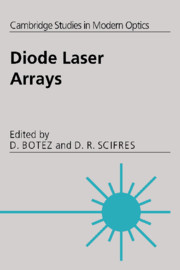Book contents
- Frontmatter
- Contents
- List of contributors
- Preface
- 1 Monolithic phase-locked semiconductor laser arrays
- 2 High-power coherent, semiconductor laser, master oscillator power amplifiers and amplifier arrays
- 3 Microoptical components applied to incoherent and coherent laser arrays
- 4 Modeling of diode laser arrays
- 5 Dynamics of coherent semiconductor laser arrays
- 6 High-average-power semiconductor laser arrays and laser array packaging with an emphasis on pumping solid state lasers
- 7 High-power diode laser arrays and their reliability
- 8 Strained layer quantum well heterostructure laser arrays
- 9 Vertical cavity surface-emitting laser arrays
- 10 Individually addressed arrays of diode lasers
- Index
1 - Monolithic phase-locked semiconductor laser arrays
Published online by Cambridge University Press: 10 November 2009
- Frontmatter
- Contents
- List of contributors
- Preface
- 1 Monolithic phase-locked semiconductor laser arrays
- 2 High-power coherent, semiconductor laser, master oscillator power amplifiers and amplifier arrays
- 3 Microoptical components applied to incoherent and coherent laser arrays
- 4 Modeling of diode laser arrays
- 5 Dynamics of coherent semiconductor laser arrays
- 6 High-average-power semiconductor laser arrays and laser array packaging with an emphasis on pumping solid state lasers
- 7 High-power diode laser arrays and their reliability
- 8 Strained layer quantum well heterostructure laser arrays
- 9 Vertical cavity surface-emitting laser arrays
- 10 Individually addressed arrays of diode lasers
- Index
Summary
Introduction
Phase-locked arrays of diode lasers have been studied extensively over the last 15 years. Such devices have been pursued in the quest to achieve high coherent powers (> 100 mW diffraction limited) for applications such as space communications, blue-light generation via frequency doubling, optical interconnects, parallel optical-signal processing, high-speed, high-resolution laser printing and end-pumping solid-state lasers. Conventional, narrow-stripe (3–4 μm wide), single-mode lasers provide, at most, 100 mW reliably, as limited by the optical power density at the laser facet. For reliable operation at watt-range power levels, large-aperture (≥100 µm) sources are necessary. Thus, the challenge has been to obtain single-spatial-mode operation from large-aperture devices, and maintain stable, diffraction-limited-beam behavior to high power levels (0.5–1.0 W).
By comparison with other types of high-power coherent sources (master oscillator power amplifier (MOPA), unstable resonators), phase-locked arrays have some unique advantages: graceful degradation; no need for internal or external isolators; no need for external optics to compensate for phasefront aberrations due to thermal- and/or carrier-induced variations in the dielectric constant; and, foremost, beam stability with drive level due to a strong, built-in, real-index profile. The consequence is that, in the long run, phase-locked arrays are bound to be more reliable than either MOPAs or unstable resonators.
- Type
- Chapter
- Information
- Diode Laser Arrays , pp. 1 - 71Publisher: Cambridge University PressPrint publication year: 1994
- 23
- Cited by



